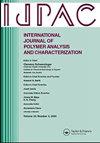调整新型可生物降解乙基纤维素/氧化石墨烯纳米复合材料的性能
IF 1.6
4区 工程技术
Q4 POLYMER SCIENCE
International Journal of Polymer Analysis and Characterization
Pub Date : 2025-05-13
DOI:10.1080/1023666X.2025.2502811
引用次数: 0
摘要
本研究通过不同浓度的还原氧化石墨烯纳米填料研究了新型可生物降解乙基纤维素(EC)/还原氧化石墨烯(rGO)纳米复合材料的可调性能。采用简单的化学混合方法制备了EC/rGO纳米复合材料。系统研究了还原氧化石墨烯含量对纳米复合材料结构、光学和电学性能的影响。结果表明,氧化石墨烯的加入使纳米复合材料的晶粒尺寸增大,位错密度减小,微应变减小。研究发现,rGO的掺入能够显著降低带隙约0.62 eV,乌尔巴赫能量增加约0.76 eV,纳米复合材料的折射率增强较小。此外,还发现了D、G、2D和(D + G)模式来定义纳米复合材料的拉曼光谱。从FTIR光谱中,证实了复合材料中存在C - h, C = O和C - O拉伸振动。此外,电学约束,如介电常数、耗散因子、交流和直流电导率,以及频率指数,被发现通过增加掺入的氧化石墨烯纳米填料的强度而增强。因此,这些发现为设计可生物降解的多功能纳米复合材料提供了重要的见解,为其在可持续包装、电子和生物医学设备中的应用铺平了道路。本文章由计算机程序翻译,如有差异,请以英文原文为准。
Tuning the properties of novel and biodegradable ethyl-cellulose (EC)/rGO nanocomposite
This study investigates the tunable properties of novel and biodegradable ethyl cellulose (EC)/reduced graphene oxide (rGO) nanocomposites by varying concentrations of rGO nanofillers. The EC/rGO nanocomposites were prepared by an uncomplicated chemical mixing route. The influence of rGO content on the structural, optical, and electrical properties of the nanocomposite was systematically studied. The obtained results reveal that the incorporation of rGO enhances the crystallite size with reduced dislocation density and micro-strain in the nanocomposites. The incorporation of rGO was found capable of reducing bandgaps significantly by a magnitude of ∼0.62 eV with an increase in Urbach energy of ∼0.76 eV and a less enhanced refractive index of the nanocomposite. Further, D, G, 2D, and (D + G) modes were found to be present to define the Raman spectra of the nanocomposites. From FTIR spectra, the presence of C–H, C = O, and C–O stretching vibrations in the composite was confirmed. Moreover, electrical constraints, such as dielectric constant, dissipation factor, and ac and dc conductivity, along with frequency exponent, were found to be enhanced by increasing the strength of the incorporated rGO nanofiller. Thus, the findings provide critical insights into the design of biodegradable and multifunctional nanocomposites, paving the way for their application in sustainable packaging, electronics, and biomedical devices.
求助全文
通过发布文献求助,成功后即可免费获取论文全文。
去求助
来源期刊
CiteScore
3.50
自引率
5.30%
发文量
37
审稿时长
1.6 months
期刊介绍:
The scope of the journal is to publish original contributions and reviews on studies, methodologies, instrumentation, and applications involving the analysis and characterization of polymers and polymeric-based materials, including synthetic polymers, blends, composites, fibers, coatings, supramolecular structures, polysaccharides, and biopolymers. The Journal will accept papers and review articles on the following topics and research areas involving fundamental and applied studies of polymer analysis and characterization:
Characterization and analysis of new and existing polymers and polymeric-based materials.
Design and evaluation of analytical instrumentation and physical testing equipment.
Determination of molecular weight, size, conformation, branching, cross-linking, chemical structure, and sequence distribution.
Using separation, spectroscopic, and scattering techniques.
Surface characterization of polymeric materials.
Measurement of solution and bulk properties and behavior of polymers.
Studies involving structure-property-processing relationships, and polymer aging.
Analysis of oligomeric materials.
Analysis of polymer additives and decomposition products.

 求助内容:
求助内容: 应助结果提醒方式:
应助结果提醒方式:


